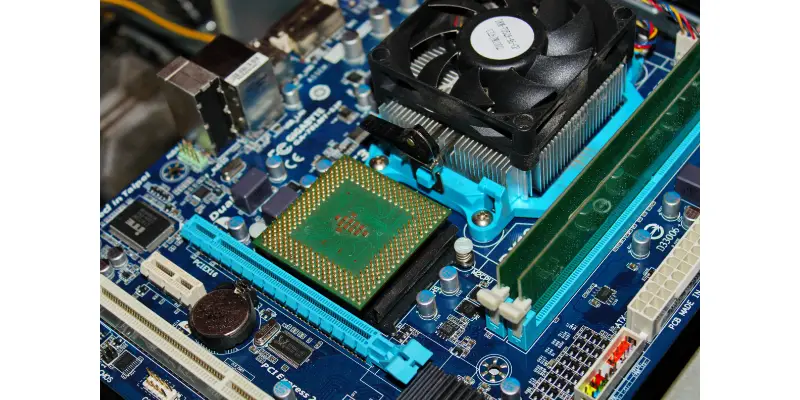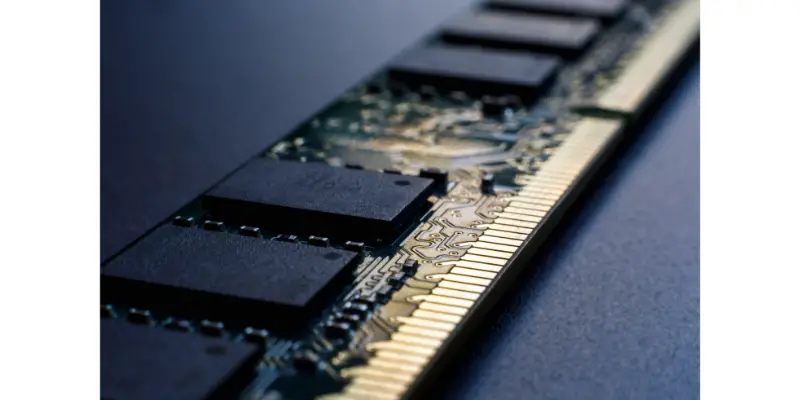Disclaimer: This post may contain affiliate links, meaning we get a small commission if you make a purchase through our links, at no cost to you. For more information, please visit our Disclaimer Page.
Random Access Memory (RAM) is a computer’s short-term memory. It’s the key to faster performance. Are you reflecting on a new computer upgrade? RAM is a superb place to start. You might be even wondering how much RAM your motherboard can handle.
In theory, your motherboard can handle an unlimited amount of RAM. In practice, there are some limits to how much RAM your motherboard can handle. For post-2007 motherboards, your motherboard can probably handle 16 GB of RAM.
This article isn’t a shopping guide, and it barely scratches the surface of a deep topic. Still, it contains tons of information about RAM. So, if you’re interested, keep reading.
Table of Contents
How Do You Know How Much RAM Your Motherboard Supports?
RAM is a hardware component that temporarily saves information while you’re using computer programs. When you have more RAM space, you can store more data. Thus, your computer runs faster.
However, you can’t install an unlimited number of RAM because you have physical limits such as hardware and operating systems.
Each motherboard model will support a finite number of RAM. So, before everything, you may need to know how much RAM your motherboard can support.
Here are some steps you can follow to discover how much RAM your motherboard can support:
1. Find Out Whether Your Windows Machine Is 32-bit Or 64-bit:
Windows can only support two system architectures, which are 32-bit and 64-bit. When you install more RAM than the system can handle, the extra RAM would be unreadable.
For example, when you install more RAM on 32-bit Windows, the motherboard won’t recognize it.
Luckily, finding out whether your Windows is 32-bit or 64-bit is a piece of cake. You right-click on the “My Computer” icon on the desktop and left-click on “Properties.”
On Windows 7: Control Panel > System and Security > System and see “System type.”
Find the Windows version in the window that will pop up to determine whether your Windows is 32-bit or 64-bit.
When it’s 32-bit, it can support up to 4 GB of RAM regardless of its version. When it’s 64-bit, it can support up to 128 GB of RAM if it’s Windows 10 Home and 2 TB if it’s Windows 10 Pro.
2. Find Out Your Mac Model
When you’re using a Mac, the RAM capacity depends on the model you have. Different Mac models will support different amounts of RAM.
In that case, you may want to check the user’s manual. Or the documentation of your particular model.
You can check if your Mac needs more RAM in the Activity monitor:
- Choose Apple menu > About This Mac, click Memory, then click Memory Upgrade Instructions.
- Choose Apple menu > About This Mac, click Support, then click Hardware Support.
3. Checking Out RAM Capacity On Linux
32-bit Linux machines can support up to 64 GB of RAM. However, older versions of Linux will only support 4 GB.
On paper, a 64-bit Linux machine can support up to 17 billion GM of RAM. In the real world, it supports 1 TB on Intel systems and 256 TB on AMD64.
The best way to find out the maximum RAM capacity for your Linux is “dmidecode.”
CTRL + ALT + T to open the Terminal.
Type sudo apt install dmidecode and hit enter to install dmidecode.
After installation, enter sudo dmidecode -t 16 and find the “maximum capacity” field.
If your Linux distro doesn’t support dmidecode, try the alternative for your particular system.
Inspect Your Motherboard Physically:
So, these were the steps to find out the RAM capacity of your motherboard through your operating system. Alternatively, you may try to inspect your motherboard visually.
It’s a vital step because when your motherboard doesn’t have additional RAM slots, it won’t matter what your operating system is saying. First of all, check out the documentation of your motherboard.
If you can find it, search online. You can find your motherboard’s brand and model by checking your system’s properties. If that’s not possible, you may have to open your computer case and check for yourself.
If you can find the package and documentation of your motherboard, you can search the brand and model online. However, the user’s manual itself should contain information about the RAM capacity of a given motherboard.
When inspecting your motherboard, you should look for how many RAM slots it has. When installing RAM, you install it in pairs.
When your motherboard can support 16 GB of RAM with four slots, it’s best to install 8 GB sticks rather than four 4 GB sticks. Why? Because that’s how you achieve maximum performance.
By Using A RAM Scan Tool
Can’t find out the RAM capacity from your operating system, documentation, or motherboard visual inspection? You may want to try a system scanning program.
If you know your favorite RAM manufacturer, their website probably provides a free scanning tool.
For example, Crucial provides a free RAM scanning tool for Windows.
The website of your computer’s manufacturer might also give you a clue about your RAM capacity.
Most of all, before you install a new RAM, make sure your system supports it. Be sure that the RAM is compatible with the motherboard as well.
Does RAM Mhz Have To Match The Motherboard?
RAM Mhz must match the motherboard for a smooth performance.
When you add two different RAM sticks with varying Mhz, the motherboard will automatically configure itself to the one with the least Mhz.
For example, if you add two RAM sticks, one 2133 MHz the other 2400 Mhz, the motherboard will configure to the 2133 Mhz RAM stick.
RAM must also match each other. When you use two or more RAM sticks that aren’t compatible, your computer will stop working. You might get a beep when you have incompatible RAM sticks.
If your computer works with incompatible RAM, it won’t be long until it crashes or burns the motherboard.
What’s RAM Overclocking?
Furthermore, you might try overclocking to avoid this situation. Overclocking allows you to get maximum performance from your RAM, but it’s dangerous.
Don’t try overclocking unless you know what you’re doing. Manufacturers test their components before releasing them to the market and stamp them with the common market standard.
It means computer components can have a higher performance than advertised. It’s because manufacturers have to comply with market standards, and they can’t put a different performance rate for each piece individually.
Overclocking will help you get the most out of the RAM. But again, don’t try it unless you’re sure what you’re doing lest you break your machine.
Manual RAM Setting
If your motherboard allows it, you might find a configuration setting in the BIOS menu to configure your RAMs for maximum speed.
If you can’t find it, that means your motherboard will always automatically configure RAM speed for you.
In general, an older model of the motherboard can support a newer model of RAM Mhz. But that’s not the case 100% of the time.
Be exceptionally careful with matching the RAM to your motherboard. It’s not a joke. Be more than skeptical, be suspicious.
Make sure the RAM Mhz matches the motherboard.
It’s possible to use 1600 Mhz RAM on a 1333 Mhz motherboard. However, you may waste resources, money, and time.
Whether it was a gift or a wrong purchase, you won’t get the most out of your RAM. Your hypothetical 1600 Mhz will run slower than it can.
In that case, you might want to seriously consider overclocking your motherboard. That way, you can get near or the full performance of your RAM.
If it works, you’ll enjoy a better system performance. If it goes north, your motherboard won’t boot.
But be careful because you might burn the motherboard.
You might want to do in-depth research before attempting to overclock your motherboard. Better yet, consider consulting a trusted computer technician.
Can Your Motherboard Support More RAM?
As you’ve seen, RAM\Motherboard compatibility is paramount for untroubled performance.
Even when you work your way around the compatibility issue, the performance would be less than optimal.
When you’re upgrading your computer’s memory, you might be wondering if your motherboard can support more RAM.
Let’s see. For starters, your new RAM must match your motherboard to the best of your ability. So, don’t be afraid to drill the seller with specific questions. Also, do your research and find out the RAM type for your particular motherboard.
Every motherboard in the world can only support a specific amount of RAM. It can only uphold a definite type of RAM and not others.
So, whether your motherboard can support more RAM depends on the make and model of the motherboard. How?
First, let’s get to know the types of RAM available today:
- Single Data Rate (SDR) is the legacy RAM that started before 2002.
- Double Data Rate 2 Synchronous Dynamic Random-Access Memory (DDR2 SDRAM) started in mid-2004.
- Double Data Rate 3 Synchronous Dynamic Random-Access Memory (DDR3 SDRAM) appeared in late 2007.
- Double Data Rate 4 Synchronous Dynamic Random-Access Memory (DDR4 SDRAM) developed in 2014.
- Double Data Rate 5 Synchronous Dynamic Random-Access Memory (DDR5 SDRAM) released in 2020.
- GDDR6 is still in the talks.
As you can expect, each generation of RAM builds on the previous one. RAM gets faster, consumes less energy, and provides lower latency with each generation.
It’s imperative to understand now that if your motherboard supports DDR2, for example, it can’t support DDR3.
If it supports DDR3, it won’t support DDR4, and so on.
Every RAM generation can fit in a specific model of motherboards. They have clear-cut pins and that will work only inside the slot in the motherboard.
Furthermore, they have these notches that will go inside the slot. Trying to force a DDR2 in a DDR3 socket will break either the RAM stick or the motherboard.
In other words, it’s physically impossible to mismatch RAM and motherboard.
And that’ll raise the compatibility issue again. Your motherboard will support more RAM when you choose the proper installation.
How To Determine RAM and Motherboard Compatibility?
While shopping for RAM, you’ll find tons of RAM brands and types, so which one is right for you?
You can follow the steps outlined before to minimize the hit-or-miss factor. Because it can make a tangible difference in your computer’s performance, you don’t want to miss these steps.
Anyways, you can use some compatibility tools that RAM manufacturers will provide for free.
When you don’t know your system specs?
You can download the Crucial System Scanner from Crucial’s website. It’s a tool that will scan your system and recommend various upgrades.
When you know your system specs?
The Crucial Advisor is another tool that will recommend compatible upgrades when you enter your system brand, make, and model.
These compatibility tools will do the research for you and make recommendations based on your system specs.
So, you have two options to know whether your motherboard can support more RAM:
- The easy option is to go to your local computer store, let them inspect your computer, and recommend upgrades.
- The difficult option is doing your research, shopping for RAM, and installing it yourself.
Does Motherboard Support 16GB RAM?
Not all motherboards will support 16 GB RAM, especially pre-2007 computers. When you want to get 16 GB of RAM, you’re looking at DDR3 (or later) RAM type.
So, if you bought your computer after 2007, it’s more likely your motherboard will support 16 GB RAM.
It’s best if you can get the motherboard make and model. Then, contact the manufacturer through their website or ask on tech-related forums.
Knowing your motherboard make and model is half the battle.
Alternatively, you can download Speccy. The free version will provide you with advanced PC insights that will help you in your search.
Finding out whether your motherboard can support 16 GB will be as easy as putting your motherboard’s model into Google.
What Is The Maximum RAM The Board Can Hold?
The primary factors of determining the maximum RAM a board can handle are the processor, operating system, and the motherboard itself.
Together, they pose the hardware and software limits to the maximum possible RAM. As noted, you can either use a program or open your computer to find out the specs.
In any case, when you’re making hardware upgrades, you’ll always need to open your computer.
Central Processing Unit (CPU)
A 32-bit processor can hold 4 GB as a maximum amount of RAM. As for 64-bit, they can take as much as the slot will handle. Let’s say you have 4 RAM slots. If you install 8 GB RAM in each bus, you’ll get 16 GB RAM.
Your motherboard might have an internal limit that would prevent using all of the 32 GB of RAM. So, a 64-bit processor can hold as much RAM as you can install in it but will only use the amount specified by the manufacturer.
As for the 32-bit processor, it’s just a technology limit. The processor is too weak to use too much memory. Remember, the processor has to negotiate between the RAM and the graphic card. So, that would be too much to handle for such old architecture.
For a 32-bit processor, 4 GB is the maximum amount it can balance between the RAM and the graphic card.
The Role Of The Operating System
When you have a 32-bit processor, your motherboard won’t support more than 4 GB of RAM – regardless of the operating system.
The operating system version, however, poses some limits.
For Mac:
- Mac OS from 10.10 can support up to 18 exabytes.
- Mac OS X from 10.9 can support up to 128 GB.
- Mac OS X < 10.9 can support up to 96GB.
For 64-bit Windows machines:
- Windows 10 Home: 128 GB
- Windows 10 Pro: 2 TB
- Windows 10 Pro for Workstation: 6 TB
- Windows 10 Enterprise: 6 TB
- Windows 10 Education: 128 GB
For more versions of Windows, check out the compuRAM story.
Note that Windows 11 is still in development, so there’s no information available for now.
Maximum RAM For Motherboards
What if you’re running a Windows 10 Pro on a motherboard that doesn’t have enough slots to reach 2 TB? In that case, the motherboard will limit the maximum number of RAM even when your operating system can support it.
You’ll need an insane number of slots to reach 2 TB. Your motherboard, therefore, will stop supporting more RAM because there would be no room for more. Get it?
A typical desktop has between four or six slots, maybe more. But it’s not enough to meet the operating system limit. On the other hand, the CPU can’t support that amount of RAM. Why? Because it still has to negotiate between the graphic card and the RAM.
Eventually, everything will melt down. No explosions, but the system won’t even start. So, don’t worry about that.
So, it’s not only about the maximum speed you can afford. It’s also about balance.
Can You Add 8GB RAM To 4GB Laptop?
You can add 8 GB RAM to a 4 GB laptop only if said laptop is 64-bit. A 32-bit laptop won’t support more than 4 GB of RAM, however.
Again, follow the above steps to determine whether your motherboard supports more than 4 GB.
Specifically, look for how many RAM slots you have and the RAM stick. Look for the operating frequency, Mhz, and the number of channels.
For example, when you have two slots and your laptop has one 4 GB RAM stick, you can add more. Theoretically, you can install a 16 GB RAM stick and enjoy 20 GB of RAM.
But, maybe your laptop doesn’t support more than 16 GB. In that case, you have two options.
Install two 8 GB RAM, which adds up to 16 GB. You’ll lose your 4 GB RAM stick in the process.
Or you can add one 8 GB RAM to your existing 4 GB and get 12 GB. That way, you get to keep your 4 GB in place.
All in all, your laptop will support more than 4 GB when it’s 64-bit. If it’s 32-bit, it won’t support more than 4 GB.
Can I Use AMD RAM On Intel Motherboard?
Technically, it’s possible to use AMD RAM on the Intel motherboard and vice versa. When you’re optimizing for performance, it may not be the best course of action.
It’s best to resort to using AMD RAM on an Intel motherboard when you have limited options.
Most motherboards have at least two RAM slots. Some have four. You may use any RAM configuration you like. Furthermore, most RAM brands will work on most motherboards. It’s not a big issue. It’s only a question of performance.
For the best possible performance, use RAM sticks from the same brand, size, and frequency.
In short, they work best together when they share as many specs as possible.




